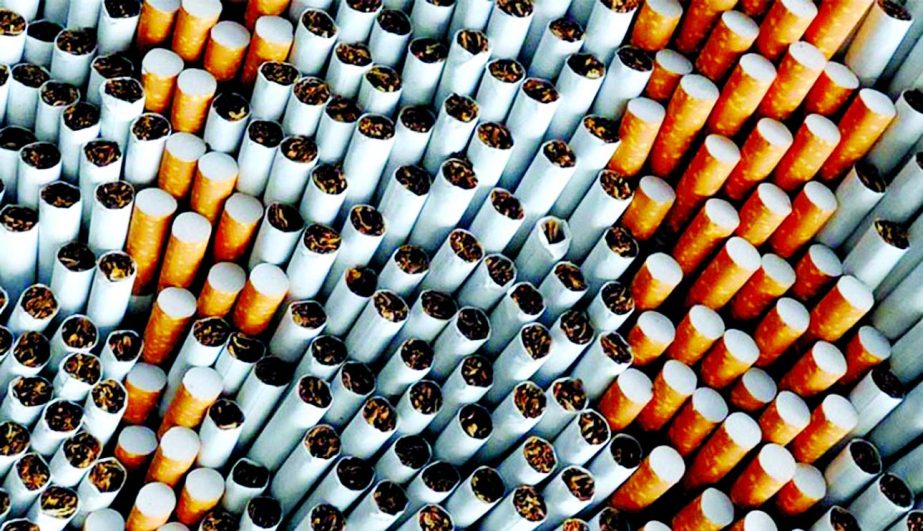
Economic Reporter :
Over 92 percent tobacco companies are not complying completely with the Graphical Health Warning (GHW) although the government has made it mandatory for tobacco packets or containers, said a survey report.
Seven anti-tobacco organizations — ACD, Dhaka Ahsania Mission, SHIMANTIK, YPSA, National Heart Foundation, Development Council and PROGGA on Sunday revealed the survey report at a press conference at Jatiya Press Club.
The survey was conducted simultaneously in eight divisional cities in November last year, after eight months of introduction of the GHW in March 19, 2016, to examine the implementation of law by tobacco companies.
“Overall, the scenario of GHW enforcement is frustrating. The rate of GHW implementation complying 100 percent of the rules, regulations and laws is still less than half,” said the survey report.
It said the scenario is more disappointing for cheap cigarettes, bidi, zarda and gul, which are mostly consumed by the illiterate and lower-income group people, although the GHW is more effective for those sections of the people.
“If the government vigilantly uses this strong tool for public health, it will play an important role to make the country tobacco-free,” added the report.
The survey was conducted at 120 tobacco-selling shops in eight divisional cities based on seven indicators. Those are: printing of GHW covering at least 50 percent of the packet/ container, printing GHW on both sides of packets or containers, printing only government approved image and message as GHW, updating the GHW image in every three months, following government approved ratio in printing GHW image and warning text and others.
PROGGA Coordinator Hasan Shariar during presenting the findings said the rate of 100 percent compliance in GHW printing is very frustrating.
“In around 51 percent of the cases, GHW is not printed abiding the law entirely,” he added.
The data analysis, from the research, has found that 100 percent of bidis (60 packets), 96.4 percent of zarda (456 containers), 75.86 percent of gul (44 containers), and 20.88 percent of cigarettes (185 packets) have not complied with the GHW law properly.
“Similarly, company-wise data analysis shows that 151 (92.07 percent) among 164 companies do not follow 100 percent compliance,” said Shariar.
According to Section 10 (1) of the Smoking and Tobacco Products Usage (Control) (Amendment) Act 2013, it is mandatory to print colored pictures about the harms caused by the use of tobacco products covering at least 50 percent of the main display area in all forms of tobacco packets, containers or cartons.
Besides, as per the Tobacco Control Law Rules, 2015 tobacco packets without GHW are not allowed to be marketed or sold after March 19, 2016 and defying the rule is a punishable offence.
The survey made recommendations to primarily compel the tobacco companies to print GHW covering 50 percent of the space on tobacco packets, ensure printing of GHW with 100 percent compliance, penalize the law violating tobacco companies and increase the number of mobile courts and make the law enforcement agencies more active.
Over 92 percent tobacco companies are not complying completely with the Graphical Health Warning (GHW) although the government has made it mandatory for tobacco packets or containers, said a survey report.
Seven anti-tobacco organizations — ACD, Dhaka Ahsania Mission, SHIMANTIK, YPSA, National Heart Foundation, Development Council and PROGGA on Sunday revealed the survey report at a press conference at Jatiya Press Club.
The survey was conducted simultaneously in eight divisional cities in November last year, after eight months of introduction of the GHW in March 19, 2016, to examine the implementation of law by tobacco companies.
“Overall, the scenario of GHW enforcement is frustrating. The rate of GHW implementation complying 100 percent of the rules, regulations and laws is still less than half,” said the survey report.
It said the scenario is more disappointing for cheap cigarettes, bidi, zarda and gul, which are mostly consumed by the illiterate and lower-income group people, although the GHW is more effective for those sections of the people.
“If the government vigilantly uses this strong tool for public health, it will play an important role to make the country tobacco-free,” added the report.
The survey was conducted at 120 tobacco-selling shops in eight divisional cities based on seven indicators. Those are: printing of GHW covering at least 50 percent of the packet/ container, printing GHW on both sides of packets or containers, printing only government approved image and message as GHW, updating the GHW image in every three months, following government approved ratio in printing GHW image and warning text and others.
PROGGA Coordinator Hasan Shariar during presenting the findings said the rate of 100 percent compliance in GHW printing is very frustrating.
“In around 51 percent of the cases, GHW is not printed abiding the law entirely,” he added.
The data analysis, from the research, has found that 100 percent of bidis (60 packets), 96.4 percent of zarda (456 containers), 75.86 percent of gul (44 containers), and 20.88 percent of cigarettes (185 packets) have not complied with the GHW law properly.
“Similarly, company-wise data analysis shows that 151 (92.07 percent) among 164 companies do not follow 100 percent compliance,” said Shariar.
According to Section 10 (1) of the Smoking and Tobacco Products Usage (Control) (Amendment) Act 2013, it is mandatory to print colored pictures about the harms caused by the use of tobacco products covering at least 50 percent of the main display area in all forms of tobacco packets, containers or cartons.
Besides, as per the Tobacco Control Law Rules, 2015 tobacco packets without GHW are not allowed to be marketed or sold after March 19, 2016 and defying the rule is a punishable offence.
The survey made recommendations to primarily compel the tobacco companies to print GHW covering 50 percent of the space on tobacco packets, ensure printing of GHW with 100 percent compliance, penalize the law violating tobacco companies and increase the number of mobile courts and make the law enforcement agencies more active.

